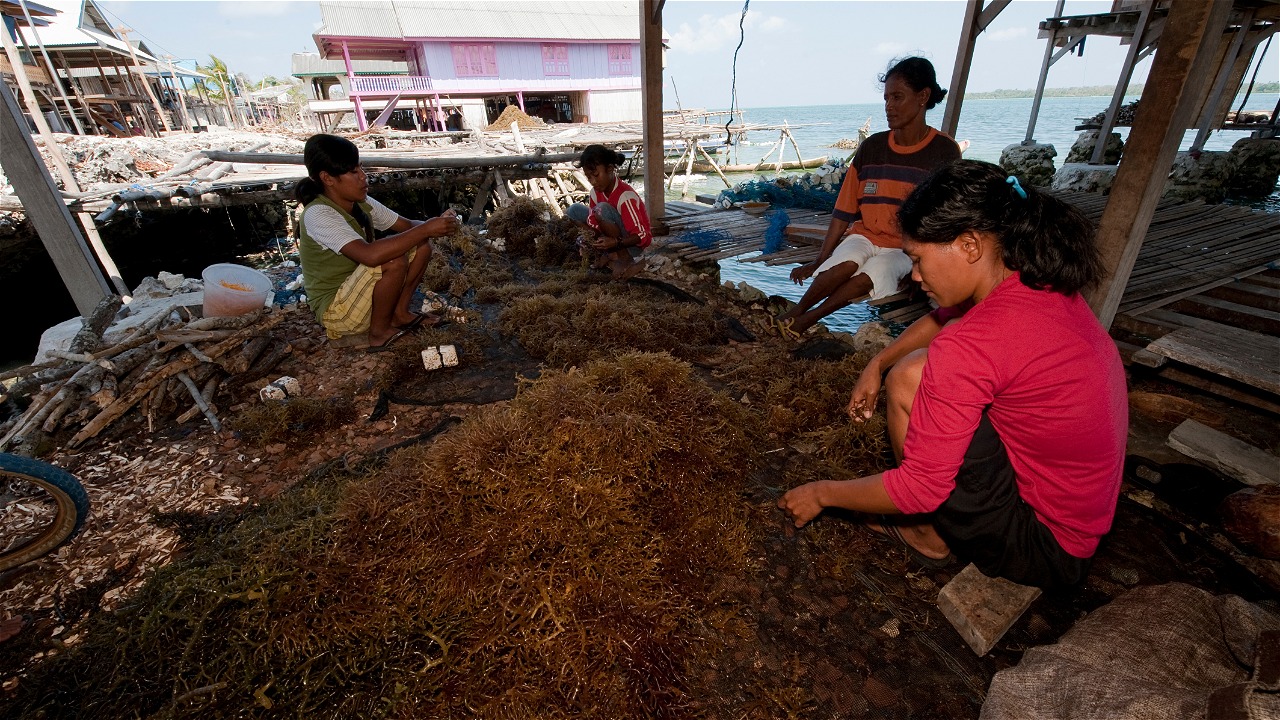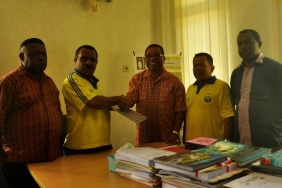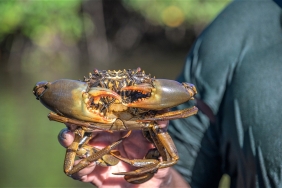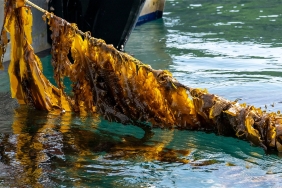LEARNING FROM EXPERTS IN COTONI SEAWEED FARMING IN BULUKUMBA
On Thursday, January 8, 2015 the WWF-Indonesia aquaculture team visited several seaweed farming sites in Bulukumba, South Sulawesi. The visit aimed to monitor seaweed farming activities and record specific methods and problems of seaweed farming in Bulukumba, as well as a series of visits to coordinate cotoni seaweed stakeholders in Bulukumba, which has been established since June 2013.
Seaweed activities consist of nursery, rearing, harvesting, and post-harvesting. On that day we met some of the grass farmers assisted by Celebes Seaweed Group (CSG).
Seedling Tying
One of the seaweed farmers, we were introduced to Sabri, and he was willing to explain the steps of attaching seaweed seedlings:
- Prepare seeds, seeds can come from the previous seaweed harvest, or come from a nursery, where the price of seeds is Rp. 3000/kg.
- Then tie the seedlings on a rope stretch of about 20 stretches per person, with a stretch length of 20 - 25 meters or 15 fathoms.
- Seedlings are installed at a distance of 30 cm, by cutting the thallus, especially at the end of the thallus. The weight of seedlings per stretch is about 5 - 6 kg/wet weight stretch.
- Ensure whether the seedlings are firmly attached or not, by twisting and shaking the seedling rope. If it is strong, the rope containing the seedlings can be trimmed and separated
- .
- The seedlings are stored for one night and then installed at the cultivation site the next day
.
That afternoon, under Sabri's house, two women were tidying up the results of tying the seedlings, which had been done since the morning. Usually, the binding of seedlings takes 3-4 days, because the number of stretches per farmer averages 300 - 400 stretches. Women are the main workers in this seedling binding activity in addition to children and teenagers, their efforts are usually valued at Rp. 3000 / stretch, if they manage to tie 20 stretches per day, they will pocket Rp. 60,000 / day.
Seaweed Maintenance
For seaweed maintenance, Subair, Chairman of Juku Ejaya Group, is the expert!
In the dry season, seaweed growth is usually slow or stunted, due to high salinity. In addition, hot days cause the growth of moss that can cover the rope and thallus of seaweed. <"We are reducing cultivation in locations with high salinity and focusing on maintenance near river mouths with standard salinity," Subair said.
Things to do if the waves are rough and hot, is to sink the seaweed a little deeper and reduce the number of floats (small bottles). A good growth period for seaweed in Bulukumba is January - August, where the weather is not extreme and water salinity is good.
Harvest
- Seaweed must be clean before lifting, the harvesting process is done by lifting the stretch onto the boat.
- After arriving on land, seaweed is dried on para-para and there is also seaweed that is hung with bamboo media. Seaweed that is dried on para-para is first straightened using bamboo, then the seaweed is dried for up to three days so that the water content is only 34-35%. While the seaweed that is hung is only straightened or released from the rope after drying for three days.
According to Subair, release after drying is better, because the seaweed has shrunk so it is easy to release, while releasing seaweed using the purus method can make the seaweed deformed or injured.
- After separating the rope from the seaweed, the rope is cleaned of moss and barnacles, then dried and tidied for reuse. Similarly, the buoys are separated and cleaned and then tidied up.
Some of the harvest is not dried, but used for reseeding. For example, if there are 400 stretches, then only 300 stretches are harvested, 100 stretches can be used as seedlings.
Dried seaweed usually has salt coming out of its thallus. However, there are farmers who deliberately add salt so that when weighed it becomes heavier. The dried seaweed is immediately sheathed and sold to seaweed collectors who are trusted or have good prices.
Post Harvest
We visited Sukardi, a collector who has been supplying seaweed to Celebes Seaweed Group for three years, and he was busy receiving seaweed from several farmers.
Post-harvest, Awi checks the quality of the seaweed by holding it, "if the seaweed is rough and slightly pointed, it means the drying is good," said Awi. In the good season, January - August, Awi can collect 100 tons/two months to be sent to Makassar, while in the bad season, September - December, Awi can only collect 50 tons/two months. He currently makes purchases to small collectors at Rp. 14,000/kg, while small collectors buy at 13,000/kg.
Seaweed cultivation in Bulukumba has good prospects for development. The socialization of BMP (Better Management Practices) of Cotoni Seaweed Cultivation continues to be carried out, because the process applied there is in accordance with the practices suggested by WWF.
If you are interested in learning more about the process of environmentally friendly seaweed farming, follow along as Socialization of BMP (Better Management Practices) for Cotoni Seaweed Farming
Author: Idham Malik (Aquaculture Fisheries Officer WWF-Indonesia)





